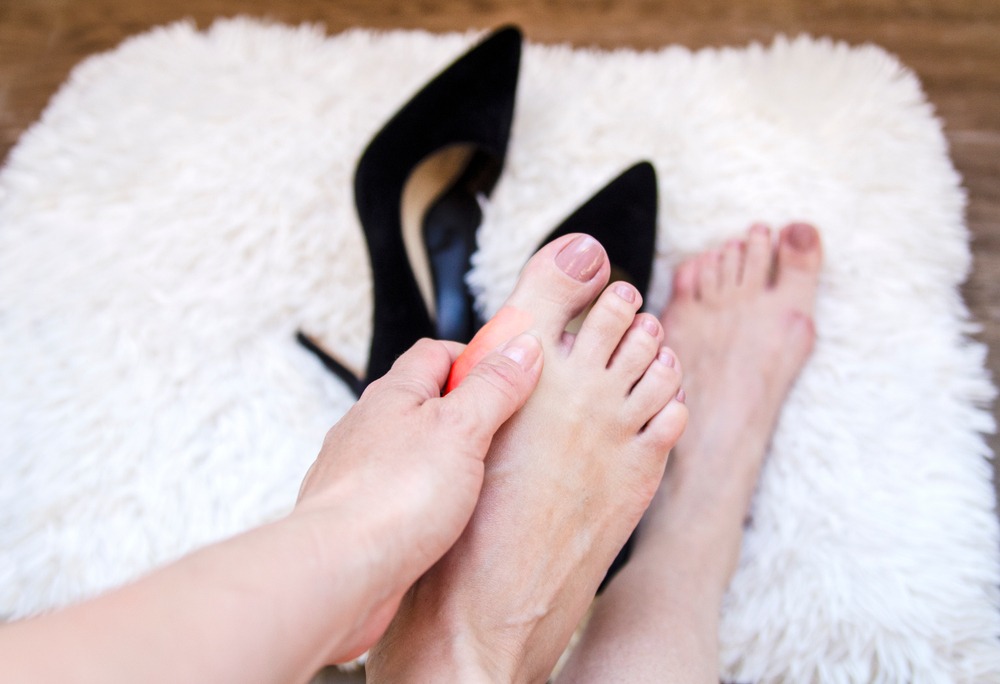
Hallux valgus is one of the most common foot deformities seen in podiatric clinics. This foot pathology is easily identified with the naked eye. Despite its common nature, it is recommended to consult a healthcare professional quickly at the first signs of discomfort. A foot bunion treated early is less likely to develop complications. Here are the causes of hallux valgus, typical hallux valgus symptoms, and how to prevent foot bunions.
What is hallux valgus?
Hallux valgus, the medical term for a bunion on your foot, is a forefoot deformity of the base of the big toe. A bunion on a big toe is a condition that can be present at birth or develop over time.
Hallux valgus deformities come in three stages. The first stage, which is considered normal, is a visible deviation of the big toe; it appears as a bump on the outside of the foot. This stage can remain painless and manageable. In the second stage, the deviation is more apparent and can be painful. It can even affect the second toe, which can become hammered or clawed. When the affected foot rubs in a shoe, it causes corns or calluses. The third stage is more painful and may require surgery. At this point, the toe is severely deformed; the person may experience such bunion pain that it may be challenging to wear shoes and walk.
Is this a common problem?
Hallux valgus is a common foot deformity that affects everyone, regardless of age. Chiropodists are often called upon to treat a bunion on a big toe. There are many solutions for hallux valgus deformities.
Symptoms of hallux valgus
The most common hallux valgus symptom is a bump at the base of the big toe joint. This bone deformity may be accompanied by pain and difficulty moving the toe. Your toe may then seem stiffer. And because the deformed foot fills more space in your shoe, corns can form where friction occurs. For the same reason, the nail of the affected toe may become ingrown and exacerbate discomfort. Finally, in some cases, hallux valgus causes deformity of your second toe.TT
The diagnosis of hallux valgus by chiropodists
A visual exam allows a chiropodist to evaluate the stage of your hallux valgus. An X-ray may be prescribed to verify the degree of impact on the bones of the foot.
Solutions and treatments offered by chiropodists for hallux valgus
There are several ways to treat bunion pain and alleviate hallux valgus symptoms. Gentle methods, such as manual therapy, are usually preferred to treat foot bunions. They are very effective when the condition is managed at an early stage. These treatments help to improve the alignment of the foot structure. They consist of therapeutic massage, which relieves tension and softens the tissues. It is usually done with another treatment, such as wearing custom-made foot orthotics. If the foot has calluses and corns, the podiatrist can remove them and prescribe creams to heal them. Finally, you can opt for protective pads to reduce friction on deformed toes. Exercises can be prescribed to prolong the effects of treatment, which help maintain the mobility of the deformed toe. However, it should be noted that a very advanced foot bunion can only be removed by surgery. A chiropodist can then refer the patient to a physician for an assessment.
What is the recovery time?
Healing a foot bunion depends on how advanced it is. A foot bunion does not disappear entirely with podiatric treatments. To get rid of it, bone surgery is necessary. However, the hallux valgus treatments offered in a podiatric clinic prevent it from worsening and improving your daily life.
Are there any contraindications to the various treatments?
Unless you have a specific chronic condition, there are no contraindications to manually treating hallux valgus. It is, therefore, essential to provide your chiropodist with any health-related information and history of past surgical procedures.
Ways to prevent hallux valgus
To avoid suffering from hallux valgus, it is recommended to wear shoes that respect the width of your foot and support its arch. Wearing such shoes reduces the risk of poor foot posture. In addition to choosing the right shoes, examining your feet by a chiropodist can help determine if certain predisposing factors are present. For example, a consultation can determine if your foot is flat or hollow or if any ligaments are hyperflexible. It is also a good time to check if the foot is well-balanced on the ground when walking. It is best to schedule a visit if you have any doubts, as hallux valgus, when detected early, is less likely to cause complications later on.
Benefit from a podiatric assessment to keep your feet healthy
Your chiropodist can offer support in treating your hallux valgus deformity. To avoid complications, it is recommended to schedule routine visits every year. A podiatric check-up is helpful for athletes and growing teenagers or older people. It allows your chiropodist to check the proper functioning of your feet and legs to detect any underlying problems before they become serious.

